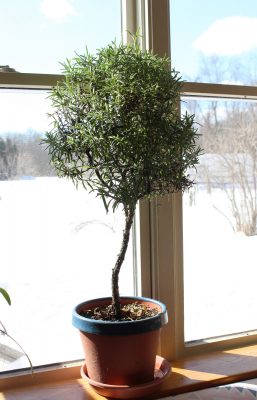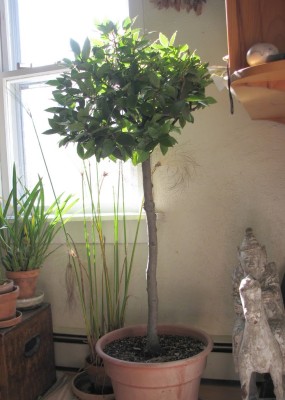The Best Winter Herbs
Mini-Trees for Flavor
Second best to fresh-picked vegetables in winter, which are not within most gardener’s grasp with temperatures in the single digits, are fresh-picked herbs. Fresh-picked herbs — indoors — in winter are within the grasp of most gardeners, even non-gardeners.
Flowering and fruiting demand lots of light energy, but it is the leaves of most herbs that provide us with flavoring, so most herbs do fine in any reasonably bright window. The same goes for normal household temperatures and humidity.
So make space near your windows for herb plants!
Let’s look below ground now. Any potting mix suitable for houseplants will also be to the liking of herb plants. The mix should hold some moisture between waterings while at the same time drain well so that roots, which need to breathe, don’t suffocate. My own mix, made from equal parts compost, perlite, peat moss, and soil, provides air and moisture as well as nutrients and beneficial microorganisms that keep plants healthy. Soil dug from the garden and used straight up is never suitable; in the confines of a flowerpot, it holds too much moisture.
Now for the plants. Many people, perhaps most, choose basil as their number one herb to grow. Nix on that, indoors. Think of a Mediterranean summer with bright sunlight beaming down on warm soil. That’s what basil needs and what you can’t provide in winter except with supplemental light and, depending on your thermostat setting, supplemental heat. Not in my house.
I’d also suggest against parsley or chives. The problem is that neither grows fast enough to keep up with periodic clipping of the amounts normally harvested.
The best herbs for indoor growing are perennial, woody, subtropical plants. Before you bemoan my nixing of basil, chives, and parsley, consider these perennials: bay, rosemary, sage, and thyme.

Small, indoor rosemary “tree”
Bay, rosemary, sage, and thyme are also good choices for indoor growing because they do double duty: They’re pretty as well as flavorful, can stand repeated harvest, and live for years and years. My bay tree started life here as a small plant carried back in my backpack from California over 25 years ago. Fresh bay tastes quite different from the dried leaf, and much, much better. My rosemary plants are each a few years old and show no signs of decline.
Both bay and rosemary are happy to be trained as bushes, as topiaries, or as miniature trees. Mine are miniature trees, each plant with a short length of trunk capped by a mop head of leaves (and flowers, now, in the case of rosemary). Their training began early, when I selected a single vigorous shoot for each plant, staked it upright, and removed all other shoots. Once shoots achieved head-height (the height of THEIR proposed head, an artistic rather than horticultural decision), I pinched out their growing tips to induce side shoots to grow. I pinched the tips of side shoots to induce them, in turn, also to branch. All this pinching induced a dense mop head of stems and leaves atop each trunk. Small, lollipop trees.
Maintenance of the bay and rosemary is easy. Both are as large as I’d like them to be so every year or two, they get tipped out of their pots and and inch or two shaved off the outside of their root balls. After returning to their pots, potting soil gets packed into the space beyond the periphery of the root balls, giving new roots access to fresh soil and nutrients.
Their heads also get trimmed periodically to maintain their neat shape. The annual trimming provides a bumper harvest, but a few leaves or stems can be clipped for seasoning any time of year.

Bay laurel
I’m not enough of a fan of sage or thyme to grow them through winter indoors. But sage could be grown as a small, decorative shrub, especially varieties such as Tricolor, with white-edged leaves, Purpurascens, with purplish leaves, or Aurea, with some gold in its leaves. Thyme, which comes in various colors and flavors (lemon or caraway, for example), is a subshrub, or ground cover. How about a thyme ground cover carpeting the ground at the feet of a potted miniature bay tree?
Ongoing care for any of these herbs is watering, which can spell the difference between success or failure. Neither rosemary, bay, sage, nor thyme readily show their thirst with wilting leaves. Years ago, as I brushed past the little rosemary tree I was growing at the time, all the leaves dropped off. The plant was dead.
The potting soil for any of these plants needs to be kept just moist. Scheduled watering won’t do because watering needs changes through the season with growing conditions. A $10 “moisture meter” is an easy way to tell whether a plant is thirsty, as is, with practice, lifting a pot to feel how heavy it is.
Carrying the Sky on Their Backs
I saw two bluebirds a few days ago, but am not ascribing any significance to the sighting. They’re just pretty.

